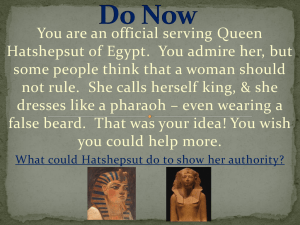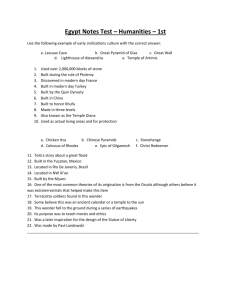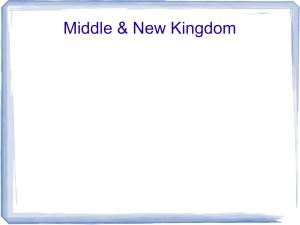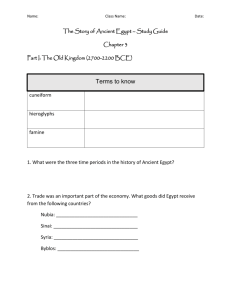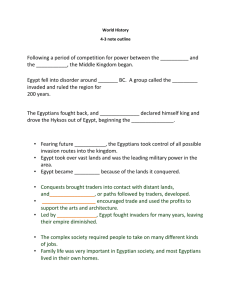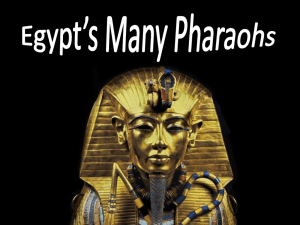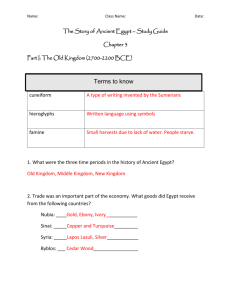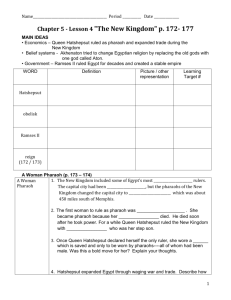Overview
advertisement
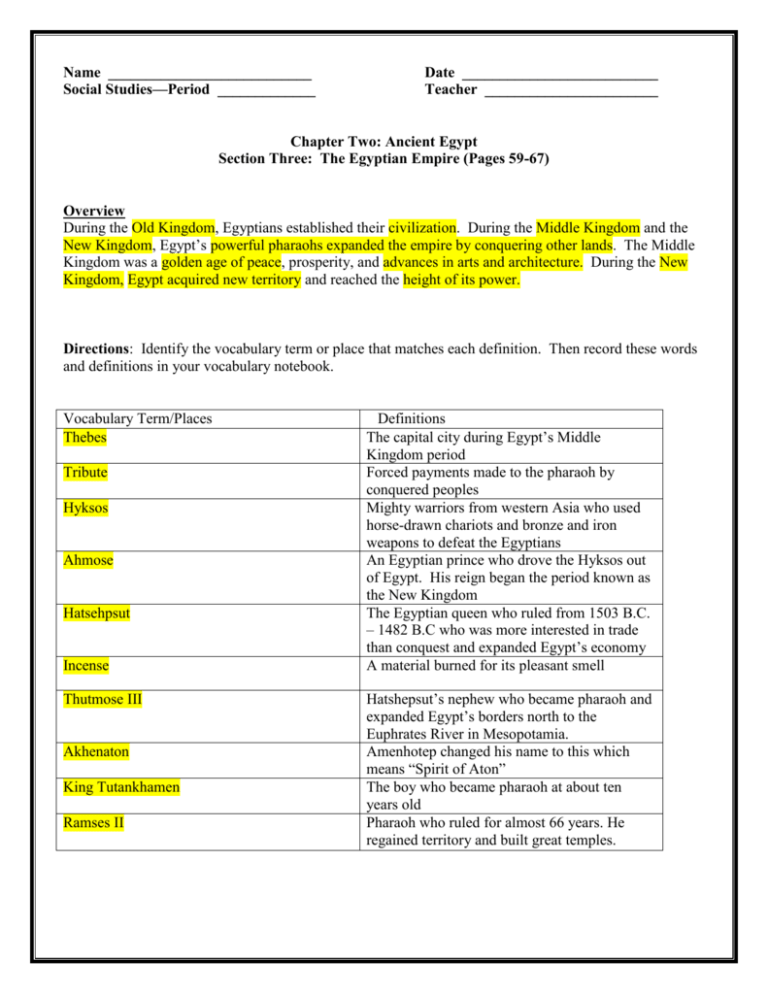
Name ___________________________ Social Studies—Period _____________ Date __________________________ Teacher _______________________ Chapter Two: Ancient Egypt Section Three: The Egyptian Empire (Pages 59-67) Overview During the Old Kingdom, Egyptians established their civilization. During the Middle Kingdom and the New Kingdom, Egypt’s powerful pharaohs expanded the empire by conquering other lands. The Middle Kingdom was a golden age of peace, prosperity, and advances in arts and architecture. During the New Kingdom, Egypt acquired new territory and reached the height of its power. Directions: Identify the vocabulary term or place that matches each definition. Then record these words and definitions in your vocabulary notebook. Vocabulary Term/Places Thebes Tribute Hyksos Ahmose Hatsehpsut Incense Thutmose III Akhenaton King Tutankhamen Ramses II Definitions The capital city during Egypt’s Middle Kingdom period Forced payments made to the pharaoh by conquered peoples Mighty warriors from western Asia who used horse-drawn chariots and bronze and iron weapons to defeat the Egyptians An Egyptian prince who drove the Hyksos out of Egypt. His reign began the period known as the New Kingdom The Egyptian queen who ruled from 1503 B.C. – 1482 B.C who was more interested in trade than conquest and expanded Egypt’s economy A material burned for its pleasant smell Hatshepsut’s nephew who became pharaoh and expanded Egypt’s borders north to the Euphrates River in Mesopotamia. Amenhotep changed his name to this which means “Spirit of Aton” The boy who became pharaoh at about ten years old Pharaoh who ruled for almost 66 years. He regained territory and built great temples. What Did You Learn? 1. What improvements did the Middle Kingdom rulers make? -Added more waterways and dams for irrigation. -Increased the amount of land used for farming. -Built a canal between Nile River and Red Sea. -Improved art and architecture. 2. What purposes did temples serve in Egypt? -Houses for gods and goddesses. -Places for priests to perform rituals, banks, and warehouses. 3. Complete the chart by filling in details about Egypt’s Middle Kingdom and New Kingdom. Middle Kingdom New Kingdom 2050 B.C. – 1670 B.C. 1550 B.C. – 1080 B.C. Important People: Important People: Hyksos Hatsehpsut Thutmose III Ahmose Akhenaton Tutkhamen Ramses II Accomplishments: Accomplishments: -Added more waterways and dams. -Trade – brought wealth -Increased land for farming. (gold, ivory, ebony and incense) -Improved art and architecture. -Conquest -Built a canal between Nile River and Red Sea. -Tut’s treasures in tomb -Rebuilding program under Ramses II constructed several new temples. 4. What was unusual about the reign of Hatshepsut? She was the first woman to rule Egypt in her own right. Read the biography on page 63 and make a list of Hatshepsut’s strengths as a leader. Then choose a present-day female leader and list her leadership strengths. Hatshepsut Present-day leader Write a paragraph comparing their similarities and differences. _____________________________________________________________________________________ _____________________________________________________________________________________ _____________________________________________________________________________________ _____________________________________________________________________________________ _____________________________________________________________________________________ _____________________________________________________________________________________ _____________________________________________________________________________________ 5. How did Akhenaton upset the traditional order? He stopped worship of old gods in favor of one god. 6. Describe the similarities and differences between the rule of Hatshepsut and Ramses II. Similar: built many temples. Different: Hatshepsut increased Egypt’s wealth through trade. Ramses II waged war to expand the empire. 7. Respond: Which of the rulers discussed in this section do you think had the greatest effect upon Egyptian history? Explain your answer using specific examples. _____________________________________________________________________________________ _____________________________________________________________________________________ _____________________________________________________________________________________ _____________________________________________________________________________________ _____________________________________________________________________________________ _____________________________________________________________________________________ _____________________________________________________________________________________ _____________________________________________________________________________________ _____________________________________________________________________________________ _____________________________________________________________________________________ _____________________________________________________________________________________ _____________________________________________________________________________________ _____________________________________________________________________________________ _____________________________________________________________________________________ _____________________________________________________________________________________ Main Ideas: During the Middle kingdom, Egypt expanded its borders, and the arts flourished. Under New Kingdom rulers, Egypt built a strong empire and expanded trade. Akhenaton failed in his attempt to create a new religion. Tutankhamen ruled briefly but gained fame because of treasures found buried with him. Ramses II was Egypt’s last great pharaoh. In the 900’s B.C., Egypt lost power to outside invaders. Death mask of Tutankhamen II Hatshepsut The Great Temple of Ramses
